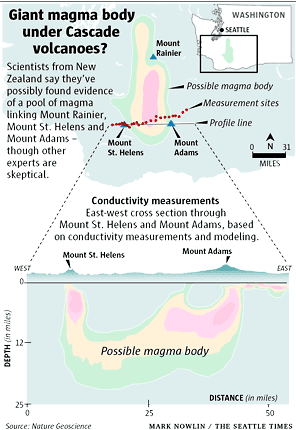
MAGMA POOL MAY LINK MT. ST. HELENS, MT. ADAMS---AND EVEN RAINIER
Sandi Doughton- Seattle Times Science Reporter
In Native American lore, the volcanoes of the Cascade Mountains chatted with each other like girlfriends.
Scientists, however, have long held that Mounts Rainier, Baker and their snow-capped sisters don't really communicate in a geologic sense.
Now, a group of researchers say they've found evidence that some of the explosive peaks are connected via a massive body of partially-molten rock that stretches between Mount St. Helens, Mount Adams and Mount Rainier.
If they're right, the magma chamber would be one of the biggest ever discovered, on a par with the pool of molten rock that underlies the Yellowstone basin. But the presence of a large magma chamber under the Cascades wouldn't mean the region is sitting atop a "supervolcano" like the one that blew Wyoming sky high in the distant past.
"It doesn't suggest there's a giant volcano waiting to pop," said hydrologist Matt Burgess, co-author of the study published online Sunday by the journal Nature Geoscience. "The significance is that it's given us a kind of a window on what's going on at depth."
Other experts are skeptical, pointing out the absence of clues that would indicate a deep reservoir of magma, like frequent earthquakes, hydrothermal vents, and surface heating and bulging. Studies that examine the way earthquake vibrations move through the ground also find no signs of a big blob of semi-molten rock, said Seth Moran, a seismologist at the U.S. Geological Survey's Cascades Volcano Observatory in Vancouver, Wash.
"If there were an extensive body of magma between those three volcanoes, we would definitely see evidence of it, " he said.
Led by scientists at GNS Science, New Zealand's equivalent of the USGS, the new research relies on a technique that can measure the electrical conductivity of geologic layers up to 20 miles underground. Magma and other fluids are better conductors than solid rock, said Burgess, who now works for the USGS in San Diego.
During the two years of field work it took to compile the data, Burgess was a graduate student who spent long hours lugging and burying the 40-pound magnets and heavy cables used for what are called magnetotelluric measurements.
"It takes a good six hours to dig in at each location," he said. One of the researchers developed stress fractures in his wrist from shoveling rocks.
The team began in 2006, when Mount St. Helens was in the midst of its most recent eruption: A three-year affair that started with explosions of ash and steam and subsided into a quiet, but prodigious outpouring of molten rock.
The scientists' magnetic measurements helped reveal new details about the vertical conduit that delivered the magma to the surface. But they also picked up hints that St. Helens' conduit was linked nearly 10 miles underground to a large area that previous studies had shown to be highly conductive.
The scientists extended their measurements east, toward Mount Adams. They concluded the neighboring volcano was also connected to the deep conductive zone.
"We're seeing that there's this large, regional body that appears to be tapped by at least two of the volcanoes," Burgess said. A single measurement hints that Rainier might be sipping from the same cup, but it's too early to make that leap, he added.
The underground mass is more like crystalline mush than liquid magma, said co-author Darren Chertkoff, of Crystal Prism Consulting, Inc. in North Vancouver, B.C. The team estimates only 2-12 percent of the rock is actually molten, he said.
The traditional view of the Cascade volcanoes has been that each is fed by a separate magma chamber. The molten rock rises from the Cascadia subduction zone, where one geologic plate is being shoved beneath another.
If the traditional view is wrong, and multiple volcanoes draw from a common magma chamber, could that mean mega-eruptions in the Northwest?
The scenario is unlikely, said Moran.
The Yellowstone supervolcano, which exploded 640,000 years ago with 1,000 times the fury of St. Helens' 1980 blast, is located at a geologic "hot spot" where molten rock rises directly from the Earth's viscous mantle and pools close to the surface.
There's no evidence Rainier, St. Helens or Adams have ever unleashed such cataclysmic blasts in the past, Moran said — which weakens the argument for the giant magma body.
But a reservoir of partially-molten rock might help explain why some volcanoes are able to pump out huge volumes of thick magma, even though their magma chambers aren't that big, Chertkoff said in an e-mail.
The new study is the "best of its kind yet," said University of Washington geologist George Bergantz, a specialist in volcanic rocks. But like all the techniques scientists use to peer into the earth, conductivity measurements only provide a fuzzy picture, he cautioned.
Most experts are convinced the "magma chamber" is actually sedimentary rock with fluid trapped in it, which could look similar in conductivity scans.
"It's a very provocative hypothesis," Bergantz said of the new study. "But it's something we have to continue to test."
Sandi Doughton: 206-464-2491 or sdoughton@seattletimes.com
seattletimes.nwsource.com/html/localnews/2010135468_volcano26m.html

